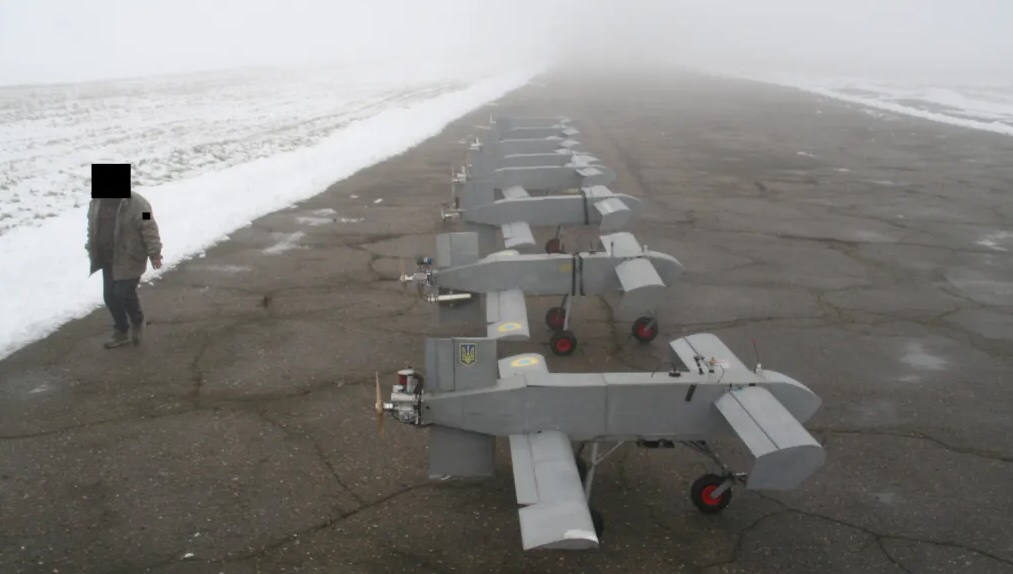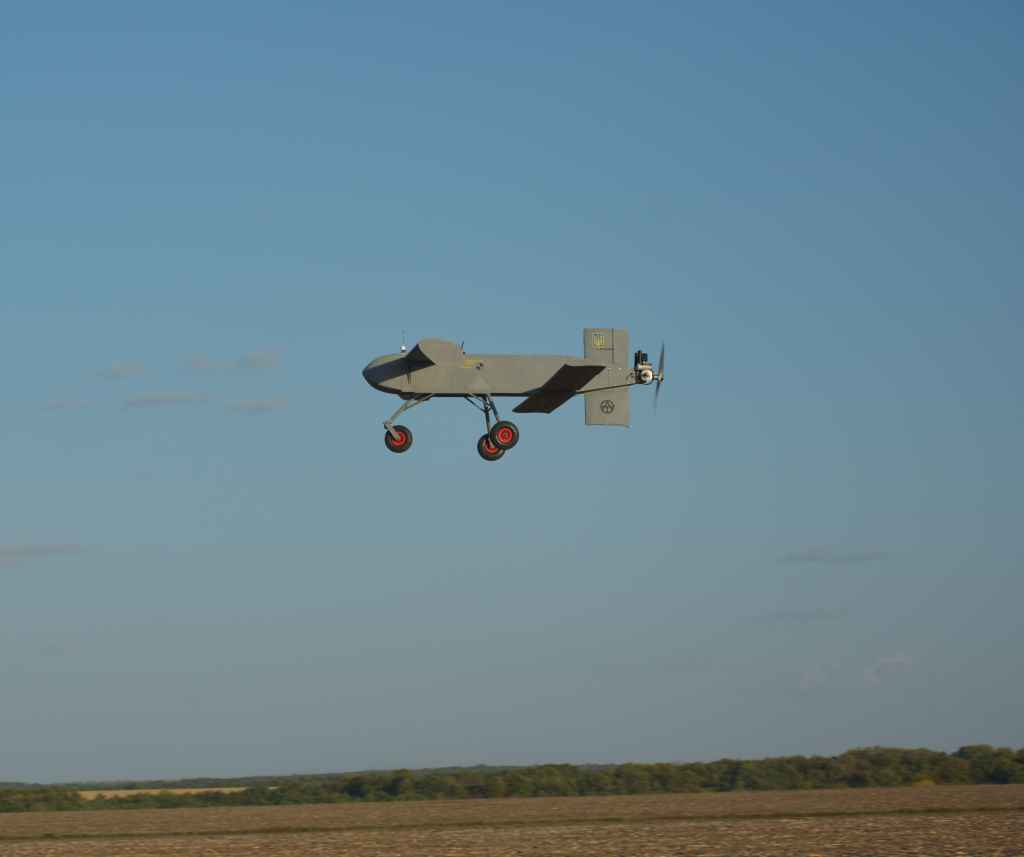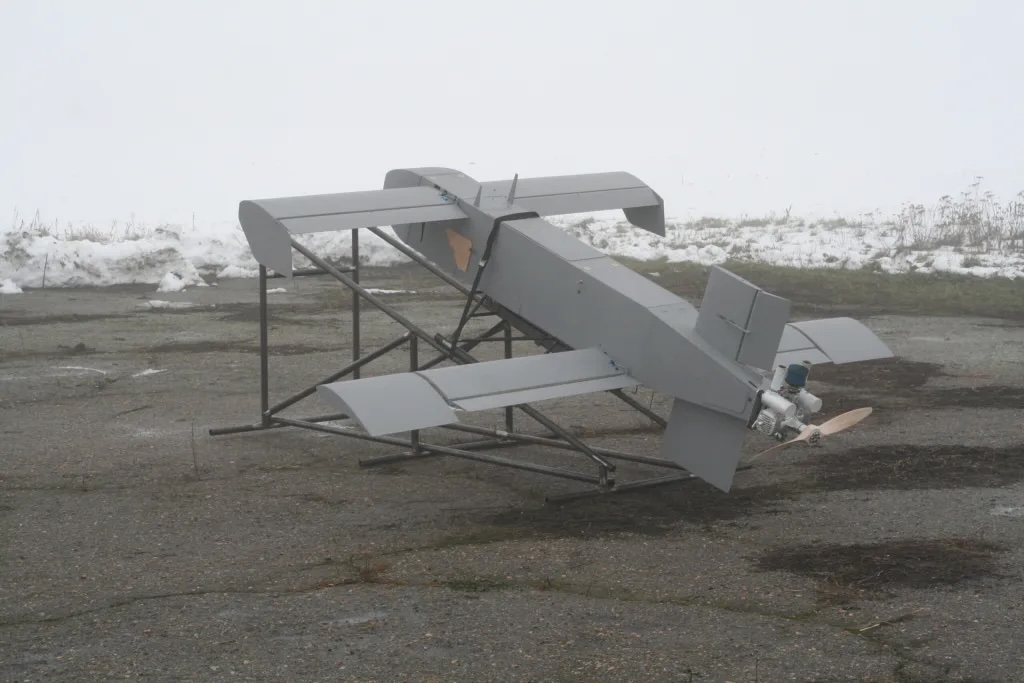
Reports that Russia‘s armed forces are starting to claw away at the specific aerial advantage Ukraine has long held with its production and skilled use of small drones took on a significant footnote this month. The qualifier designates what’s described as the mass manufactured, inexpensive AQ 400 Scythe loitering munition – a UAV capable of 750-kilometer flights deep into occupied Crimea or Russia’s heartland, and created to shift the momentum of the war in Kyiv’s favor.
AQ 400 Scythe attack drones are something of an aeronautical marvel in their combination of cutting-edge aspects of Silicon Valley tech innovation with the built-from-the-stuff-you-have grim ingenuity of war-drained Ukraine. At first glance, they look like something built from a Soviet-era Erector Set (look it up, younger readers).

The craft is produced by the international startup formerly called One Way Aerospace, which DroneDJ featured when it came out with its very fast, highly maneuverable AQV 100 Scalpel first person view (FPV) attack craft. Since that time, company officials have workied with specialized Ukraine units credited with mounting what in its earlier phases were spectacular UAV strikes on Moscow.
Now, rebaptized Terminal Autonomy, the company has unveiled the outgrowth of that latter activity with the AQ 400 Scythe long-range loitering munition. The boxy gray, dual-winged UAV may not boast the shiny exteriors and sharp, fine lines of craft produced by defense firms doing billions in annual sales, but there’s hope the UAV will prove gorgeous and slickly surgical in defending Ukraine’s independence, nevertheless.
“Following our US restructuring (and) the integration of visual targeting and navigation into our portfolio of battle-proven attritable systems, we’ve rebranded into Terminal Autonomy,” company CEO Francisco Serra-Martins tells DroneDJ. “This is ahead of a forthcoming announcement of US-licensed production with a US defense prime in 2024.”
Prior that, however, the startup will face the challenge of ramping up mass production of cheap yet affordable hi-tech flying weapons systems designed to follow the evolving actions and objectives in Ukraine’s battle against Russia.
“Moving from our portfolio of AQV Scalpel FPV quad loitering munitions to longer-range fixed-wing solutions signifies a strategic shift for increased operational reach and effectiveness,” Serra-Martins says. “This transition prioritizes extended flight endurance and larger payload capacities, enabling more versatile and precise missions while maintaining a robust operational profile.”
Eschewing the usual startup hi-tech luxuries of 3D printers and even supplies of fiberglass that are rare to nonexistent in war-torn Ukraine, Terminal Autonomy makes the drone’s body from plywood reserves, and uses landing gear that look like they were taken off the neighbor’s wheelbarrow. AQ 400 Scythe are assembled from designs that don’t require the highly skilled hands of engineers – vastly facilitating production.
Navigation and visualization tech is a mixture of sensors and communication systems that – while operationally effective and largely resistant to jamming – only raise the UAV’s final cost to a reported $30,000. As such, those comparatively inexpensive AQ 400 Scythe drones represent Ukraine’s long-in-coming answer to Russia’s Iran-supplied Shaheed loitering munitions – and then some.
When it unveiled the craft on December 13, Terminal Autonomy said it was initially producing “100 units and plan(s) to scale to 500 units monthly, (by) pushing boundaries in strategic warfare.” A lot of the program’s success will rely on its ability to reach, and surpass, those goals.
The startup created the AQ400 Scythe as a necessarily modestly funded response to Shaheed systems that Russia has punished Ukraine with for months during nightly attacks of numerous craft. The Terminal Autonomy drones are likely to be deployed in similar swarms, using the logic that even if lead craft are detected and destroyed by anti-air defenses, enough of the remainder will make it through to inflict specifically painful damage.
“Terminal Autonomy’s decision to shift to long-range loitering munitions is strategically designed to break the back of Russian industry and energy networks, and to overwhelm the Russian war machine,” Serra-Martins explained in an email to DroneDJ. “These munitions serve as a deliberate means to disrupt vital sectors of their supply chain, creating substantial disruptions that undermine their operational capabilities. This calculated approach aims to significantly weaken critical components of their economy and military.”
For that to work, the company will have to mass produce reliable and efficient AQ400 Scythe at rock bottom prices with limited supplies. In the early stages of the project, however, signs indicate the plucky, Ukraine-relocated startup may pull it off.
Capable of traveling up to 900 kilometers with lighter payload and engine options, Terminal Autonomy’s attack drone is matching its Iranian counterpart with cruising speeds of 140 kph and maximum velocity of 200 kph. Once thrust aloft by rocket launchers, catapults, or on their own power like airplanes, AQ400 Scythes can fly at altitudes up to 10,000 feet, requiring Russian forces to use expensive munitions in order to reach (and, possibly, strike) the far less expensive craft. Even those hit, Serra-Martins notes, will have forced Russia to use far costlier and limited munitions reserves.

The UAVs are designed to avoid jamming while nearing their targets by using what Forbes described as a “laser altimeter from Lightware to fly at a very low level – around 30 meters/100 feet.” The drones can then rely on ground terrain and landmarks as guides for their onboard preprogrammed visual tech, which essentially shrug off superfluous Russian signal blocking as they speed to their final destination.
At closer radio transmission range, operators have the option of piloting the 100 kg., 43 kg-toting drone using a visual feed – essentially turning it into a really big, really powerful, and (frankly) really ugly FPV craft. In that way, the UAV closes a circle opened last April when Terminal Autonomy launched its AQV 100 Scalpel to diversify and strengthen Ukraine’s small craft advantage with highly effective first-person strikes.
Now Kyiv is playing catch-up ball in the loitering munitions battle using AQ 400 Scythes to bring Moscow’s war into occupied Crimea and back deep into Russia’s own territory, where its bases, military manufacturing, supplies, and public opinion are all far more vulnerable.
FTC: We use income earning auto affiliate links. More.



Comments